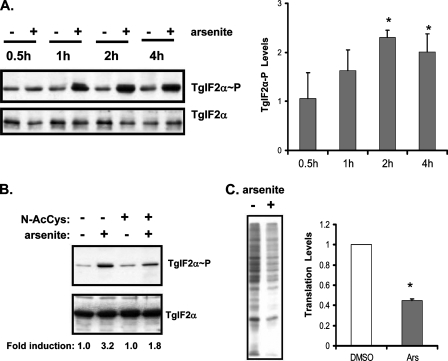FIGURE 1.
eIF2-mediated translational control in response to oxidative stress. A, tachyzoites exposed to 5 μm sodium arsenite or vehicle control over a time course were assayed for levels of TgIF2α phosphorylation by immunoblot (TgIF2α∼P). Immunoblots were also carried out with antibody recognizing total TgIF2α as a normalizing control. The right panel is a statistical analysis of three independent experiments, showing the mean ± S.E. of the -fold change in TgIF2α phosphorylation. An asterisk denotes a statistically significant difference between stressed and non-stressed parasites (p < 0.05). B, tachyzoites were exposed to 5 μm arsenite or vehicle for 1 h. Indicated samples were pretreated with 20 mm N-acetylcysteine (N-AcCys) for 30 min. Immunoblots were probed with antibodies to phosphorylated TgIF2α (upper panel) or total TgIF2α (lower panel). The -fold induction of TgIF2α phosphorylation was determined by densitometry of the autoradiogram, which was in the linear range of exposure. C, tachyzoites were subjected to 5 μm arsenite (Ars) or vehicle (no stress) for a total of 1 h. 30 min after the start of the stress treatment, [35S]Met/Cys was added to radiolabel the proteins in each sample. Samples were then resolved on SDS-PAGE for autoradiography. Changes in the level of translation were assayed in three independent experiments and analyzed for statistical significance (graph) as the mean ± S.E. An asterisk denotes a statistically significant difference (p < 0.05).

